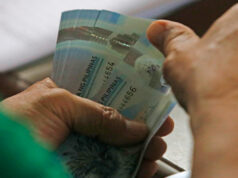Peso to weaken vs dollar
THE PESO is expected to weaken versus the dollar today following the better-than-expected jobs report in the United States.
On Friday, the peso ended the week at P52.10 against the greenback, up eight centavos than Thursday’s P52.18, driven by dovish cues from the Bangko Sentral ng Pilipinas despite a slower-than-expected March inflation print.
Week on week, the peso also strengthened from the P52.50 finish last March 29.
In an e-mail, a market analyst said the dollar will likely bounce back against the local currency on Monday after the US economy added more jobs than expected in March.
The US job market expanded by 196,000 in March, the Bureau of Labor Statistics reported.
On the other hand, the unemployment rate was steady last month at 3.8%, sitting below the 5% upper threshold considered as strong by the US Federal Reserve.
“The dollar’s appreciation due to these relatively strong US labor reports might be amplified by safe-haven buying amid lingering concerns on Brexit and the US-China trade talks,” the market analyst added.
Meanwhile, Rizal Commercial Banking Corp. economist Michael L. Ricafort said there might be “some upward correction” for the dollar-peso to the P52.20-per-greenback levels “after stronger US jobs data and possible monetary easing after lower-than-expected inflation.”
Inflation stood at 3.3% in March, the Philippine Statistics Authority reported on Friday, easing for the fifth straight month and near the lower end of the 3.1-3.9% forecast range of the central bank.
The Bangko Sentral ng Pilipinas hinted that any cut on local policy rates or reserve requirements may not be immediate, Mr. Ricafort said, as monetary easing will only be considered if inflation goes down further to 3%.
The market analyst expects the peso to trade between P51.90 and P52.60 this week, while Mr. Ricafort said the peso could range from P51.80-P52.20 today.
Meanwhile, the Department of Finance said the local unit tracked its Southeast Asian peers in gaining strength versus the US dollar for the first quarter.
Year-to-date, the peso appreciated by a modest 0.01%.
“While the outlook for the peso remains tilted towards the downside (owing to a growing current account deficit, which, in turn, is on account of increased importation of capital goods), the country’s external stance remains generally strong,” the Finance department said in an economic bulletin.
The generally strong stance of the country against headwinds offshore was attributed to ample buffers as well as trimmed exposure to external debt. — Karl Angelo N. Vidal



